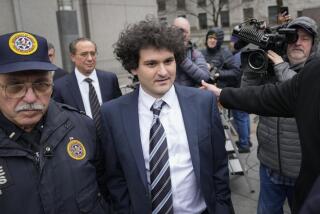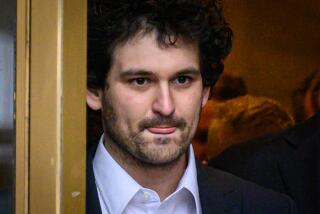BREAKING THE BANK: The Decline of BankAmerica<i> by Gary Hector (Little, Brown: $17.95)</i>
Driving down a country road one day to get an important agricultural account before his competitor, Bank of America founder A. P. Giannini realized he couldn’t win unless he took a shortcut. Remembering that the road doubled back over a bridge, Giannini undressed, tied his clothes in a bundle, swam across the river holding the bundle over his head, dressed, and walked to the farmer’s house. He had a signed contract and was out the door before the other salesman arrived. Journalist Gary Hector presents stories like this as tales of a bygone era, symbols of the ingenious and self-sacrificing spirit that could have prevented BankAmerica from slumping into its present financial crisis. As Hector contends in this compelling chronicle, by losing sight of Giannini’s principles after he died in 1949, BankAmerica’s executives--steely cool managers rather than visionary leaders--lost control of their company. BankAmerica tumbled from record profits in 1980 to a loss of more than $1 billion between 1985 and 1986.
An outward symbol of what was happening in the bank was its 52- story headquarters in San Francisco, completed in 1969. A hulking, brown tower, it was seen as “a cold and inhuman structure.” In lending a human dimension to this hard world of facts and figures, Hector takes his share of dramatic liberties. His story sometimes has a more mythic than realistic ring, rose-tinting the past to play upon our modern-day disillusionment with huge bureaucracies. And yet, while Hector’s character profiles might be played up for effect (the stories about Giannini, for one, could be apocryphal), Hector’s criticism of decision-making at the bank remains convincing. BankAmerica suffered because its executives set their sights only on short-term profits, Hector contends. Clausen, for example, is portrayed as a detail man who could rattle off the bank’s financial ratios from memory, but who needed to keep telephone numbers for his home and office in his wallet.
In a conclusion encouraging for banking in America if not for BankAmerica, Hector contends that company leaders also erred by not being democratic. By hiding bank losses and drawing $575,000 salaries despite the bank’s near-failure, Clausen and Samuel Armacost, BankAmerica’s other top executive in recent years, only undermined the trust on which banks are founded. In so doing they lost their base of shareholder support, a keystone during the reign of Giannini, who had built a bank to serve “the little fellow, just as Henry Ford had built a company to produce automobiles for Everyman.”
More to Read
Inside the business of entertainment
The Wide Shot brings you news, analysis and insights on everything from streaming wars to production — and what it all means for the future.
You may occasionally receive promotional content from the Los Angeles Times.










